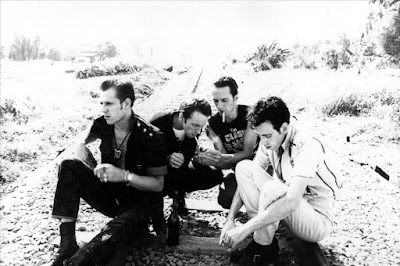The Beatles entered Decca Studios in London on New Year's Day 1962, for their first-ever audition for a record label. Nervous, hungover from the previous night's celebration, and unable to use their own amplifiers, they struggled through fifteen songs, which were chosen as they best represented their live act at the time. The audition came about because Decca had been going through a major reshuffling in its roster, necessitating new artists, and through Brian Epstein's ties with Decca (he did own Liverpool's biggest record store, after all), he got them to do a Commercial Test, as they were called. Newly hired A&R man Mike Smith was the one put in charge of finding new talent, and even though he wasn't very impressed with their performance (especially with their drummer), he still thought them worthwhile and wanted to sign them. But because of company policy, Decca insisted he only sign one act out of the two he had recently auditioned: he'd get either Brian Poole and the Tremeloes or the Beatles. He went with the more professional and established Tremeloes, as they were the safer bet, and the Beatles drifted for a while before signing with Parlophone six months later. And the rest, as they say, is history.
But what if the Beatles had passed their Decca audition? To answer that question, we will be presenting the fifteen Decca audition songs as if they were the Beatles' first studio album, with all the necessary substitutions and tweaks being made for it to slide in easily along with the rest of the Beatles' discography. That means we will be removing any songs that were featured in actual Beatles albums, trying to make this into a standalone collection of songs, a snapshot of the Beatles during the Pete Best era. It will be presented in the order it was recorded, which means we'll forego any sequencing, and only songs that either feature Pete Best on drums or are known to be performed with him will be considered. Given that it was common practice in the UK to have recordings from auditions be released as an artist's first single at the time, it's not as insane as it seems to have the audition itself be commercially released, though it was rare to have artists release albums right out of the gate. Some suspension of disbelief will be needed, of course, as we'll be working within very tight constraints, but I'm sure we can put together a decent album with what we have. With that out of the way, here's what our Decca album looks like:
Like Dreamers Do (The Decca Tapes)
The Sheik of Araby (The Decca Tapes)
To Know Her is to Love Her (The Decca Tapes)
Take Good Care of My Baby (The Decca Tapes)
Memphis, Tennessee (The Decca Tapes)
Sure to Fall (The Decca Tapes)
One After 909 (Cavern Club Rehearsal)
-
Hello Little Girl (The Decca Tapes)
Three Cool Cats (The Decca Tapes)
Crying, Waiting, Hoping (The Decca Tapes)
September in the Rain (The Decca Tapes)
Besame Mucho (The Decca Tapes)
Searchin' (The Decca Tapes)
First of all, we need to get rid of the two songs that were later featured on With the Beatles in late 1963: "Money (That's What I Want)" and "Till There Was You", to avoid repetition. Now down to thirteen songs, our next task is to find one more tune to fill out the album and have it be a 14-track record, like all other Beatles records up to 1966. And although recordings from the Best era are pretty hard to come by, we do have a few candidates, such as a cover of Roy Orbison's "Dream Baby", recorded for their first BBC appearance later that March, and Joe Brown's "A Picture of You", also recorded for the BBC in June. The Lennon/McCartney original "One After 909", the only other original in their live repertoire by January 1962, survives as recorded in a rehearsal at the Cavern taped that August, with one caveat: Ringo's on drums. Pete had already been sacked by the time it was captured, so to include it, we'd have to deal with that anachronism. Given that they only performed three originals for Decca, "One After 909" seems like the most sensible inclusion, and we'll have to leave it to our imaginations as to what a version with Pete would have sounded like, had they recorded it properly for Decca in January 1962.
Clocking in at 33 minutes, Introducing the Beatles is a very capable, if not brilliant, debut album, one that shows both the strengths and weaknesses of the Beatles as they were in 1961. It's not, of course, anywhere near the level of any of their other studio albums, but as a curiosity, it does quite a good job. Would it have sold well? Who knows, but with "Hello Little Girl" b/w "Like Dreamers Do" as the first single, the two most immediately commercial and poppy songs performed at the audition, I'd say they'd have at least a fair shot at making the top 50. We title our reconstruction Introducing the Beatles as it sounds like the kind of generic first album title Decca would probably come up with, and it fits this collection of songs well. As for the album cover, it was made by AndrewskyDE over at SHF, and was one of the main inspirations behind this reconstruction, using one of the Beatles' best photos with Pete Best and the original Beatles logo as designed by Paul McCartney. So thanks to him! While Ringo and George Martin's absences are very much felt, this proves to be an invaluable document of the Beatles at their rawest, captured nervously trying to convince the Decca suits that their dream was worth it.
Sources:




.png)



.png)
